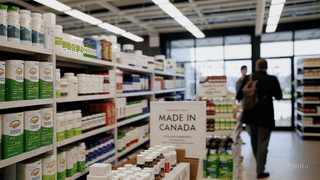
The Canadian government’s “remission process” will allow businesses to apply for exemptions or refunds on tariffs if they can prove that affected goods cannot be reasonably sourced domestically or from non-U.S. suppliers. Additionally, case-by-case exceptions will be considered where tariffs could have a severe impact on the Canadian economy.
Finance Minister Dominic LeBlanc underscored the importance of the measure, stating, “We want to preserve this relationship, but in the face of the unjustified U.S. tariffs against Canadian goods, we are taking action to protect our economy, our workers, and our businesses. We will always stand for Canada.”
As Canada retaliates with its own tariffs—starting with $30 billion worth of consumer goods on Tuesday, followed by an additional $125 billion in the coming months—businesses across multiple sectors, including health and wellness, are bracing for economic repercussions.
How the Trade Dispute Impacts Health and Wellness Businesses
The health and wellness industry in Canada is deeply connected to international trade, particularly when it comes to imported raw materials, finished products, and medical supplies. With tariffs being imposed on a wide range of consumer goods—including cosmetics, dietary supplements, and wellness products—the industry faces potential price hikes, supply chain disruptions, and regulatory challenges.
Many health and wellness products, from vitamins and supplements to skincare and personal care items, are manufactured in or sourced from the United States. With new tariffs in place, Canadian importers will face higher costs, which could then be passed on to consumers.
Popular American brands in organic skincare, plant-based supplements, and fitness-related nutrition products could see price increases, making them less accessible to Canadian consumers. Retailers and wellness clinics that rely on U.S. suppliers for specialty health products may struggle to maintain their pricing structures, potentially leading to reduced profit margins or lower sales.
Supply Chain Challenges for Canadian Pharmacies and Clinics
Pharmacies, wellness clinics, and holistic health practitioners often depend on American-made medical and wellness products, including diagnostic tools, medical devices, and specialty pharmaceuticals. If these items are subject to tariffs, delays in sourcing and increased costs could disrupt operations.
For example, products such as orthopedic supports, rehabilitation equipment, and even certain medical-grade supplements could become more expensive or harder to obtain. While some products may be sourced from Europe or other regions, the transition to new suppliers could take time and involve regulatory hurdles.
Impact on Natural and Organic Health Markets
The natural health industry, which includes organic foods, plant-based supplements, and holistic remedies, is also vulnerable. Many superfoods, such as organic nuts, seeds, and plant-based proteins, are imported from the U.S., and tariff-related cost increases could discourage consumer purchases.
For Canadian businesses that specialize in organic wellness products, the challenge will be finding alternative suppliers outside of the U.S. while maintaining product quality and compliance with Canadian regulations. The government’s remission process may provide relief for some businesses, but it remains unclear how efficiently the system will work and how many companies will qualify for exemptions.
A Balancing Act for the Government and Businesses
As the trade dispute unfolds, Canadian policymakers must strike a balance between defending national economic interests and minimizing harm to businesses and consumers. While retaliatory tariffs send a strong political message, they also risk making essential products less affordable, particularly in sectors like health and wellness, where accessibility is key.
Businesses in the industry will need to be proactive in assessing their supply chains, seeking alternative suppliers where possible, and applying for tariff relief if eligible. Meanwhile, Canadian consumers may have to adjust to higher prices on some of their favourite wellness brands—at least until trade relations stabilize.
What’s Next?
The coming months will determine how significantly the health and wellness sector is impacted by the tariffs and whether businesses can successfully navigate the government’s remission process. For now, industry leaders and policymakers alike will be closely monitoring trade negotiations, hoping for a resolution that prioritizes economic stability without compromising the availability of essential health and wellness products for Canadians.









